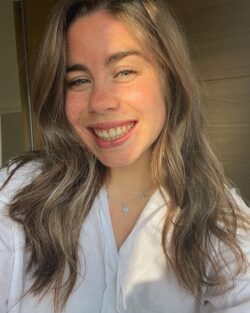LIFD Early Career Researcher Spotlight: Emily Butler

Our monthly spotlight focuses on the work and lives of the researchers from the Leeds Institute for Fluid Dynamics
Thesis Title
An investigation of the fluid-structure interaction arising in articular cartilage across disparate scales.
School/Faculty
CDT in Fluid Dynamics, School of Computing
Supervisors
Dr Greg de Boer, Dr David Head, Dr Mark Walkley and Prof Michael Bryant
Tell us a bit about yourself
I am currently in my third year of the fluid dynamics CDT and therefore the second year of my PhD. Before becoming a post graduate researcher, I completed an MMath in Mathematics at the University of Sheffield. My decision to join the Fluids CDT was because of a summer research placement I carried out between my third and fourth year of my undergraduate studies. This project was at the University of Sheffield on the topic of turbulence modelling in pipe flows using direct numerical simulations. This project really kick-started my interest in research, particularly within computational fluid dynamics and marked the first time I even considered doing a PhD!
Alongside my PhD research, I really enjoy immersing myself in the community of fluid dynamics and mathematics, taking part in various outreach events, teaching computing, and working to support disabled students with their studies.
When I am not working, I train and compete with the university performance rowing team. I also enjoy running and cycling, which are mostly motivated by the coffee and pastries I award myself with during/after!
When I am not working, I spend all my spare time training and competing with the university performance rowing team
I really enjoy balancing my work and studies with exercising outside. I end up sending all of my spare time rowing for the university performance squad, cycling and running.
What is your research about?
My research focusses on computational modelling of articular cartilage, a tissue found at opposing surfaces in knee joints. It provides a smooth bearing surface, promoting low friction articulation and facilitating continuous operation under relative motion. Cartilage tissue is crucial for healthy movement of joints; however, it has a lack of cells, rendering a low capacity for intrinsic healing or repair. This leaves the tissue prone to degeneration and disease, resulting in a high clinical demand for cartilage repair. To streamline treatment, an accurate computational model of the tissue is essential to inform rapid pre-screening of therapeutic interventions.
My project aims to close a gap, where current models do not capture the key mechanical properties and fluid-structure interactions arising within cartilage. The model I am creating aims to couple an immersed fibrous network (micro-scale) model with a continuum (macro-scale) model, using Heterogeneous Multi-scale Methods to create a multi-scale model that can capture the fluid-structure interaction arising within AC across disparate scales. Once the model is established, I would like to introduce the zonal structure of the tissue and use damage modelling to try to understand how cartilage tissue breaks down and the effect this has on the mechanical properties of the tissue. If I create a successful model, it could help to inform how this breakdown in the tissue is arising and the model could be advanced to inform clinical interventions in the future.
I am really motivated by the application of this work and have relished the opportunity to immerse myself in the field of bio-mechanical fluid dynamics, something which I had no knowledge of before starting my research here at Leeds.
What did you wish you knew before starting a PhD?
When first starting a PhD, I thought I would make a lot of progress day to day, however tasks take so much longer than anticipated and do not always correlate directly to tangible research outcomes. Working at the forefront of new research is certainly exciting, but the day-to-day grind is a challenge not to be underestimated, particularly when working on building a new computational model! I have managed to balance this frustration by taking every opportunity to learn and develop my skills around the PhD, whilst managing to break up the long days. I have made the most of conferences, outreach events and teaching and hope to attend many more events to disseminate my research in the coming year. I believe this is helping me to become a well-rounded researcher and preparing me well for a career after my PhD.
What are your plans for the future?
My plans for the future are uncertain at the moment since I still have 15 months left of my PhD, but I am excited to explore the range of options. I am very interested in the clinical applications of my work and would certainly like to research this further, perhaps even move towards a research career in this field. Outside of a research career, I am also very interested in pursuing my part-time work as a disability support worker and would love to qualify as British Sign Language interpreter if I can save up to afford it!
